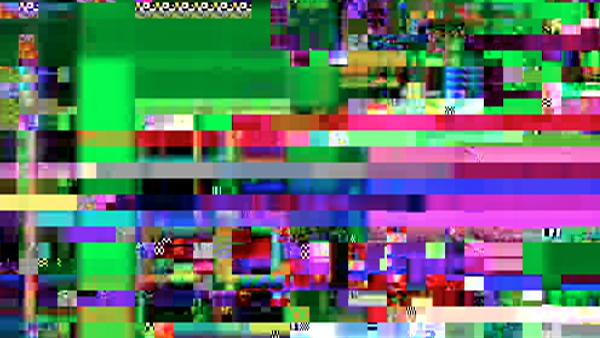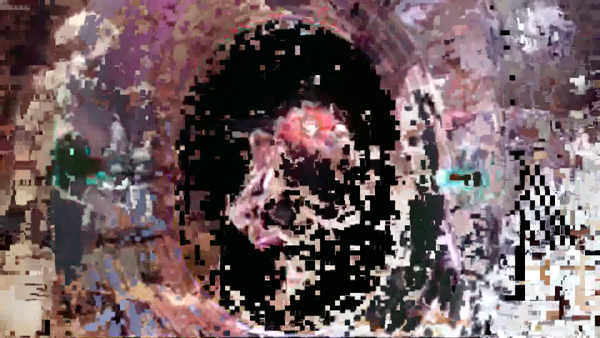
�Glitch� may be best known from its role in electonic music and digital composition, but it is equally�and more commonly�a part of the everyday visual engagement with computers. The technical aspects of digital technology�pixellated images that re/compose reality as a juxtaposition of discrete fragments�suggests a translation of visual space into a virtuality, cyberspace, that instead of being continuous is instead shot through with errors and failures of various types. Transfers between this digital technology and art have been a continuous part of its history, but the prominence of digtial imagery and digitally-derived forms has become an insistent part of contemporary media since the opoular embrace of the Internet in the mid-1990s. These visual forms of glitch, unlike its musical counterparts, have consistently been grouped with a variety of other terms, prominent among these are post-digital, post-internet and the new aesthetic; in academic contexts visual glitch will often simply identified with new media art, or occasionally video art.
However, an engagement with the visual products of computational processes is not enough to define the �glitch.� It is specifically the results of aberrant and apparent �abnormal� renderings by digital technology that are of interest. The complexities of these identifications, as David Barry and Michael Dieter note in the introduction to their anthology Postdigital Aesthetics (2015), that �the everyday experience of life within computal societies inspires a search for new concepts and experience, or perhaps �formal indicators� as vague neologisms, in an attempt to historically delimit and define the present.� [Berry, David M. and Michael Dieter. �Thinking Postdigital Aesthetics: Art, Computation and Design� in Postdigital Aesthetics: Art, Computation and Design ed. David M. Berry and Michael Dieter (New York: Palmgrave Macmillan, 2015) p. 4.] The varied terminologies and approaches identifying the emergent digital as a dominant cultural model reflect the difficulties they describe. The designation �glitch� occupies a prominent place within the �formal indicators� describing the transition from a world identified with continuity and the pixelated, sampled world familiar from digital screens. In Postdigital Aesthetics historians Christiane Paul and Malcom Levy explain the scope of these formal elements� emergence for art:
The terms �glitch� and �corruption artifacts� in the broadest sense refer to images and objects that have been tampered with; their creation relates to the core of the media apparatuses used to store, produce and relay information. These corrupted images can be created by adjusting or manipulating the normal physical or virtual composition of the machine or software itself, or by using machines or digital tools in methods different from their normative modalities.
[Paul, Christiane and Malcom Levy. �Genealogies of the New Aesthetic� in Postdigital Aesthetics: Art, Computation and Design ed. David M. Berry and Michael Dieter (New York: Palmgrave Macmillan, 2015) p 31.]
Glitch procedures engage and reflect technical failures in digital systems�one is tempted to describe glitch as �courting disaster��since the results of these processes verge on a complete systemic/structural failure. These same transient failures employed as aesthetic material were discussed in 2000 by Kim Casone�s earlier article in Computer Music Journal. �The Aesthetics of Failure: �Post-Digital� Tendencies in Contemporary Music� proposed glitches as a material element that he identified with the procedural basis of digital media�the digital is generated autonomously:
The �post-digital� aesthetic was developed in part as a result of the immersive experience of working in environments suffused with digital technology: computer fans whirring, laser printers churning
out documents, the sonification of user-interfaces,
and the muffled noise of hard drives. But more specifically, it is from the �failure� of digital technol
ogy that this new work has emerged: glitches,
bugs, application errors, system crashes, clipping,
aliasing, distortion, quantization noise, and even
the noise floor of computer sound cards are the
raw materials composers seek to incorporate into
their music. [Cascone, Kim. �The Aesthetics of Failure: �Post-Digital� Tendencies in Contemporary Computer Music� in Computer Music Journal, Vol. 24, No. 4 (Winter, 2000), p. 12-13.]
The list that Cascone identifies is not limited to technical failures, but includes a range of physical elements that might be equally categorized as �intrusions� upon the idealized encounter with a digital work; his designation of these as �post-digital� reflects their emergence after the action of the digital machine (or perhaps in excess to it). His list collectively describes those elements which accompany immaterial digital production, but are indicative of its physical, material nature. They are �formal indicators� of computational action, the �noise� that surrounds and arises from the operation of hardware and software.
The ascendant prominence of this �noise� follows the logic in philosopher Jacques Attali�s argument about the domestication of noise in the form of music, in the control exercised by recording:
With noise is born disorder and its opposite: the world. With music is born power and its opposite: subversion. In noise can be read the codes of life, the relations among them. Clamor, Melody, Dissonance, harmony; when it is fashioned by man with specific tools, when it invades man�s time, when it becomes sound, noise is the source of purpose and power, of the dream�music. [Attali, Jacques. Noise: The Political Economy of Music (Minneapolis: University of Minnesota Press, 1985) p. 6.]
Applying Attali�s theory of noise to a definition of glitch offers an understanding of their potential for transgression in the violation of the established codes of perception and order (Attali relies on earlier aesthetic theory by Theodor Adorno to develop this critical dialectic). The material markers that Cascone lists as elements in the digital glitch music have visual analogues�but their imagistic counterparts are precisely those elements typically ignored when encountered. Their shift in focus from the periphery to being central to the work is a particular attempt to counter the tendency to ignore the glitch, to cast it out of consciousness. Attali�s concept of �noise� also contains the seed of its elision�the order he identifies rejects these elements, rather than engaging or even acknowledging their presence�glitches are part of our contemporary digital media experience that appear not as a violation of media�s perfection, but as transient surface flaws which rapidly vanish from both our screens and our consideration. Their banality as well as insignificance in relation to the actual foci of interest, the information they accompany, renders them forgotten almost instantly after they have passed.

Following Attali, Cascone conceptualizes a �critical role� for glitches appearing in the work of composers such as Ryoji Ikeda. The network of historical and ideological foundations that are common to the digital as a whole encourages an interpretation of these glitches as indicative of the materially of the digital technology�elements that are rapidly discarded as extraneous; thus glitch elements are �background��as the elided part of the encounter and interpretation:
The basic composition of �background� is comprised of data we filter out to focus on our immediate surroundings. The data hidden in our perceptual �blind spot� contains worlds waiting to be explored, if we choose to shift our focus there. [Cascone, Kim. �The Aesthetics of Failure: �Post-Digital� Tendencies in Contemporary Computer Music� in Computer Music Journal, Vol. 24, No. 4 (Winter, 2000), pp. 13-14.]
The invisibility Cascone identifies with digital glitches is the aura of the digital in action, stripping of these physical elements of digital media as simply epiphenomena. Constructing a critical analysis of glitch thus requires a consideration of the ideological apparatus built up around and supported by digital technology, a rejection of the aura of the digital, that recognizes how digital machines instantiate the assumptions and foundations of capitalism in instrumental form; however, these critical interpretations of glitch are also inherently problematic because the vehicle of this critical engagement�the glitches�rupture only the apparently seamless media experience under specific and limited circumstances. The tendency, as Cascone notes, is to identify them as �background,� a dismissal as superficial flaws of the immanent encounter, not as significant material demonstration that requires further analysis or interpretation. This is what the designation �glitch� commonly signifies: a lack of significance, that it is �background� to be elided from consideration.
That the digital object is completely distinct from the instantiation of it in some physical form makes the idealization that is foundational for the aura of the digital seem immanent, paradoxically realized in the immaterial digital file itself. The glitch as epiphenomenal asserts an absolute difference between the physical encounter and the digital itself: this transcendent ideal applied to digital technology is the aura of the digital; it has an �aura of information� composed from both a machine-generated and a human-readable work created by the computer from a digital file (itself actually stored in some type of physical media).
Material dimensions of glitch enable a reappropriation of historical production that is easily associated with earlier fetishes of the artist�s �hand� in historically materialist art. Those material features of historical cinema (camera, lenses, graininess, flicker) draws attention to the mechanical photographic medium itself; a similar collection of features could be readily identified for digital media, including but not limited to resolution, compression, artifacts�as well as technical errors of all types in any reproduction technology�the same elements Cascone listed. The challenge to capitalism seemingly posed by these material markers has a specific historical lineage originating in an ironic semiotics of �skilled craft� common to the nineteenth century Arts and Crafts movements and their heritage: the appearance of visible brush strokes, imperfections and natural variation in manufacture such as hammer marks or bubbles, that were the historical signs of unskilled labor. These lists of material markers allude/claim to evoke the physicality of production�both glitch and other historical errors of film parallel the opposition to the idealized/supposed �perfection� of machined production in the Arts and Crafts� productions. Continuity with the material world has been systematically obscured by the fantasy that digital production is fundamentally and categorically different from the historical physical production of industrial capitalism. The shift from human to digital labor is the historical result of industrial capitalism�s attempts to replace the variable costs of labor with the fixed costs of machinery. These analogues for the material markers of production in the �immaterial� visual shifts the form but not the historical critique of capitalism's deskilling of production and labor towards an embrace of unintelligent, unskilled labor that can readily be replaced by automation.
Digital capitalism emerges as this process of automation progresses and human labor is replaced by machines capable of increasingly sophisticated actions that historically required the intelligent labor of humans but which digital system now perform faster, cheaper and more consistently. This transition produces a dematerialization of value into the immaterial production philosopher Katerina Kolozova explains in Towards a Radical Metaphysics of Socialism:
There is nothing material in the 21st century�s form of capitalism. Contemporary capitalism is not only based on �immaterial labor,� as Negri and Hardt claim, but also on pure abstraction and elevation to the immateriality of both labor and capital. This situation is the result of the complete mathematization and speculation of the real. [Kolozova, Katerina. Towards a Radical Metaphysics of Socialism (New York: Punctum Books, 2015) p. 41.]
The transition to digital technology is a dissolution of concerns with physicality and a denial of material basis. The glitch can act as a �stoppage� of this autonomous production, a transitory failure whose critical potential depends on violating this aura of the digital. Glitch, in this interruptive role, suggests the materiality of media, offering the potential for a transition into a critique of digital capitalism, requiring a refusal of mystification: the productive, material and historical connections between industrial capitalism and digital capitalism proceed from a matrix of precise control that connects the seemingly immaterial action of autonomous machinery to earlier protocols of industrial production that rendered their (necessary) human labor unintelligent. How glitch can achieve this making-conscious is the problem posed by the aura of the digital stripping of any and all temporary interruptions from consciousness as merely an epiphenomenon, without significance. There is no easy or simple "solution" to this problem; simply employing glitch in media work does not automatically produce a critical meaning.
|

|